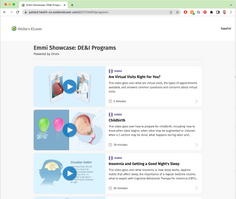.png)
Emmi patient engagement
BRAND DEVELOPMENT | CONTENT CREATION | MOTION GRAPHICS
THE CHALLENGE: Modern healthcare is a complex interplay between providers, payers and caregivers. Aligning these decision makers is key to creating better outcomes. But unfortunately there's one critical part of the care team that is often overlooked: the patient.
As complexities and costs rise along side innovation, it's essential that clinicians, support staff and patients are reading from the same playbook. That's where empathetic and approachable patient education is key to driving better financial and health outcomes for all parties involved.
The problem is that most healthcare providers have logistical challenges of their own and are ill equipped to meet health consumers on their terms. That's where Emmi plays the role of a critical ally.
THE SOLUTION: Emmi is a suite of patient education and engagement content that blends art and science to better empower patients to be a part of key decision making.
Health consumers bring expectations from their digital lives—the desire for simplicity, seamless access and engagement.
Emmi meets these expectations head on, using a mix of illustration, voice and content (the art) to deliver evidence-based medical information through behavioral science practices (the science) that encourages patients to play an active role.

THE WORK: As Creative Director, my remit was to reinvigorate and refocus a talented but disparate creative team following a merger with Wolters Kluwer Health.
To do so, I established an internal creative studio model—aligning the production art, medical art, UX design and content teams to better serve the various needs across the organization.
The first step was rallying the team around a common vision—our Passionate Purpose (below).
The outcome was a nimble and experienced cross-functional creative team that supports Emmi's several products, while also outsourcing our expertise to other areas of the organization that are critical for a seamless user experience (e.g. clinical decision making, population health, etc.).
We strategically organized around best practices (art, UX, content) and encouraged collaboration to get the most out of each discipline. The result was a more nimble and innovative team that helped Emmi to meet the expectations of our savvy digital users—and helped set a foundation for delivering more innovation and creative thinking.

With this vision in mind, the creative team continued developing a wide range of content, from interactive multimedia programs that helped patients self-direct their learning, to simplified print material to longitudinal condition-based programs that would deliver content on a regular basis for months or more.
Embracing and celebrating diversity was another key component to building patient trust. So we developed design tools that gave us flexibility in showcasing different skin color, gender representation, body types and mobility levels. We also employed a wide range of voice actors, knowing that patients will inherently trust voices that come from their own community.
This representative art direction helps increase engagement, but so too does the way that the content is built and delivered.
Our UX team developed a variety of web-based tools using modular and responsive frameworks to optimize the design for a range of devices—very important when nearly 70% of patients are engaging via mobile devices.
Special attention was given to designing with web accessibility standards in mind—adding aria labels and transcripts to support screen readers and integrating adjustable closed captioning and playback controls. Not only does this support access for those with disabilities, but generally makes the experience better for all users.
Another strategic decision was to more consistently tie the Emmi look and feel into the overarching WK corporate brand. With very different audiences (B2B decision makers for WK; health consumers for Emmi), we needed to blend the empathetic, illustrative style of Emmi with a professional and simple brand wrapper that would be recognized as part of WK.
Despite the different modalities, topics and knowledge levels, the consistency of the Emmi voice and style allowed us to create more seamless experiences for patients and their care team—all by increasing and encouraging participation through thoughtful design and empathetic communication.
The result is a patient population that is more educated and empowered to play a key role in their healthcare journey. Not to mention a brand that is redefining the expectations for patient engagement.




















